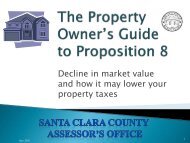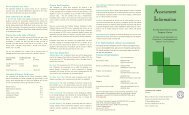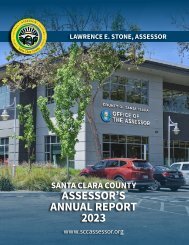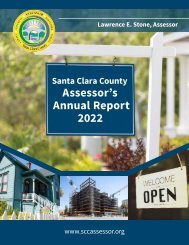New Construction and Property Taxes Santa Clara County
The effect of new construction, altering an existing building, or changing the use of a property have on property taxes.
The effect of new construction, altering an existing building, or changing the use of a property have on property taxes.
You also want an ePaper? Increase the reach of your titles
YUMPU automatically turns print PDFs into web optimized ePapers that Google loves.
NEW<br />
CONSTRUCTION<br />
AND<br />
PROPERTY TAXES<br />
What Effect Does <strong>New</strong> <strong>Construction</strong>, Altering an<br />
Existing Building or<br />
Changing the Use of a <strong>Property</strong> Have on<br />
<strong>Property</strong> <strong>Taxes</strong>?<br />
Lawrence E. Stone<br />
Assessor<br />
“<strong>New</strong> construction” is one of<br />
the most common reasons a<br />
property is reassessed <strong>and</strong><br />
the assessed value increased<br />
beyond the Proposition 13<br />
protected 2% annual<br />
increase. It is important to<br />
underst<strong>and</strong> that an appraisal<br />
is an estimate of market<br />
value. An assessment is the<br />
value placed on a tax roll.<br />
Normally “new construction” is thought of as<br />
building a new structure, or adding on to an<br />
existing structure. Under California property tax<br />
law, “new construction” can also mean<br />
renovating a structure to change its use,<br />
rehabilitating a structure to a “like new”<br />
condition, or even removing a structure.<br />
However, not every building permit for new<br />
construction results in a reassessment of the<br />
property. In general, the Assessor’s office<br />
processes thous<strong>and</strong>s of building permits<br />
annually, yet typically less than half result in<br />
new, higher assessments.<br />
This brochure is designed to help property<br />
owners <strong>and</strong> taxpayers underst<strong>and</strong> when new<br />
construction results in a reassessment.<br />
Generally, value is added for new<br />
construction under the following<br />
circumstances:<br />
1. <strong>New</strong> building(s) constructed on<br />
vacant l<strong>and</strong>.<br />
2. Additional square footage added to<br />
an existing building.<br />
3. Additional buildings or improvements<br />
to property. For example, a garage,<br />
swimming pool or bathroom.<br />
4. Physical alteration (rehabilitation)<br />
converting a building or any portion<br />
thereof, to the substantial equivalent of<br />
a new structure, or changing the<br />
manner in which a building is used.<br />
How <strong>and</strong> when will “new<br />
construction” be assessed?<br />
In estimating new construction, only the value of<br />
the improvement being added is considered. That<br />
is, if a new building is constructed on vacant<br />
l<strong>and</strong>, the l<strong>and</strong> will retain its existing indexed,<br />
base year assessed value. 1 If an addition to a<br />
structure<br />
changes its size, for example, increasing the size<br />
of a single family residence from 1,200 square<br />
feet to 2,000 square feet, only the market value<br />
of the additional 800 square feet is added to the<br />
assessed value. A new base year value is<br />
determined for the addition only. The indexed<br />
base year assessed value of the l<strong>and</strong> <strong>and</strong><br />
existing structure(s) remain unchanged.<br />
The assessed value is determined as of the date<br />
of completion of construction. If the<br />
construction is ongoing as of the lien date<br />
(January 1), an estimate of the value of the<br />
partially complete construction is made <strong>and</strong><br />
entered on the next assessment roll. 2 When<br />
construction is complete, the base year assessed<br />
value is determined <strong>and</strong> a supplemental<br />
assessment is issued for the difference between<br />
the value as of the date construction is<br />
completed, <strong>and</strong> the value that existed on the<br />
assessment roll. The new construction is based<br />
upon market value. The Assessor may use the<br />
Sales Comparison Approach, the Cost<br />
Approach, <strong>and</strong> in case of income producing<br />
properties, the Income Approach to value the<br />
new construction. 3<br />
Will the contractor’s costs, or<br />
in the case of owner-built<br />
new construction, the<br />
owner’s actual cost, be<br />
considered in the<br />
assessment?<br />
While these costs are considered, the Assessor<br />
is obligated by California State Constitution to<br />
add the market value of the new construction.<br />
When the Sales Comparison Approach is<br />
employed, an appraisal of the l<strong>and</strong> <strong>and</strong> the<br />
improvements is done as of the date of<br />
completion to determine the value of the new<br />
construction.<br />
The Cost Approach is often employed by the<br />
Assessor to appraise new construction. It is<br />
important to note that proper application of the<br />
cost approach considers all the costs incurred in<br />
the course of construction. These “Full<br />
Economic Costs” include labor <strong>and</strong> materials,<br />
permit fees <strong>and</strong> contractor’s overhead <strong>and</strong> profit.<br />
In addition, there are indirect costs such as<br />
developer’s administration expense, professional<br />
fees, construction financing, insurance, <strong>and</strong><br />
entrepreneurial incentive or profit.<br />
Entrepreneurial incentive is defined as the<br />
amount that a developer expects to receive<br />
before a project is initiated. Entrepreneurial<br />
profit is the amount that a developer actually<br />
receives after a project is completed. A prudent<br />
developer who undertakes to construct <strong>and</strong><br />
market a property anticipates receipt of a<br />
(entrepreneurial) profit in addition to the return<br />
of the equity investment.<br />
<strong>New</strong> <strong>Construction</strong> associated with income<br />
producing properties may be assessed using the<br />
Income Approach. Here the methodology is<br />
similar to the Sales Comparison Approach<br />
because the market value of the total property is<br />
determined based on the income which the<br />
subject property could generate. The market<br />
value of the l<strong>and</strong> is then deducted to leave a<br />
residual market value of the improvements.<br />
In general, the difference in the amount of<br />
money the property would have sold for if<br />
offered for sale as it existed immediately prior<br />
to the new construction, <strong>and</strong> the amount it<br />
would sell for on the open market, immediately<br />
after the completion of construction, is the best<br />
indicator of market value.<br />
If I add square footage to my<br />
home, will it cause a<br />
reassessment of the entire<br />
property, including the l<strong>and</strong>?<br />
Under Proposition 13, the entire property, l<strong>and</strong><br />
<strong>and</strong> improvements, will only be completely<br />
reassessed when the real estate transfers<br />
ownership. If new construction occurs on only a<br />
portion of a property (for example, the addition<br />
of a<br />
bedroom), the newly constructed portion is reassessed<br />
<strong>and</strong> assigned its own base year value.<br />
The remainder of the property which did not<br />
undergo new construction (including the l<strong>and</strong>)<br />
retains its existing base year value. In some<br />
cases, the scope of work being done constitutes<br />
equivalent to new construction <strong>and</strong> the entire<br />
house will be reassessed but the l<strong>and</strong> will retain<br />
its existing base year value.<br />
What if I am just repairing my<br />
property?<br />
Normal maintenance <strong>and</strong> repair is the action of<br />
continuing, preserving or retaining property in<br />
proper condition. Maintenance performed on real<br />
property is normal when it is regular, st<strong>and</strong>ard<br />
<strong>and</strong> typical. The installation of new items that<br />
replace old items but provide a similar function is<br />
not typically considered re-assessable new<br />
construction. Routine repairs necessitated by<br />
normal wear <strong>and</strong> tear, such as replacing a water<br />
heater, carpet or roofing are not considered new<br />
construction, <strong>and</strong> are not subject to reassessment.<br />
What if I purchase a property<br />
in poor condition? Will the<br />
repairs be assessable?<br />
Purchasing a property in poor condition <strong>and</strong> then<br />
replacing multiple items in a short period of<br />
time is not st<strong>and</strong>ard <strong>and</strong> typical normal<br />
maintenance. Timing <strong>and</strong> scope of work must<br />
be considered to determine when maintenance<br />
<strong>and</strong> repair becomes rehabilitation <strong>and</strong> renovation<br />
that brings an improvement to a state that is<br />
substantially equivalent of new. Rehabilitation<br />
is defined as the restoration of a property to<br />
satisfactory condition without changing the<br />
plan, form or style of the property, <strong>and</strong> involves<br />
curing physical deterioration. If rehabilitation<br />
makes the structure substantially equivalent to<br />
new, it qualifies as re- appraisable new<br />
construction.<br />
1 A base year value is established each time there is a change in ownership or completion of construction, which, in subsequent years is modified only by applying the m<strong>and</strong>ated inflation factor, not to exceed 2%. A property with multiple<br />
completion of construction dates, or multiple partial interest transfers, will have a separate indexed base year value for each component. The total assessment is the sum of the components <strong>and</strong> is the basis for calculation of the taxes.<br />
2 The lien date is the time when taxes for any fiscal year become a lien on property; <strong>and</strong> the time as of which property is valued for tax purposes. The lien date for California property is 12:01 a.m. on January 1 (effective January 1, 1997)<br />
preceding the fiscal year for which the taxes are collected. The lien date for prior years was March 1.<br />
3 There are three universally accepted valuation/appraisal techniques to determine fair market value: (1) Sales Comparison Approach, (2) Income Approach (usually appropriate for income producing properties) <strong>and</strong> (3) Cost Approach. While<br />
the Cost Approach is a valid <strong>and</strong> useful technique for determining value of some properties, the final determination of assessed value will be based on the amount the general public would pay for the work, including a market based profit.<br />
The application of the cost approach to determine assessed value is the least preferred method of valuation <strong>and</strong> is only appropriate for special use properties, or when available market information is insufficient to render an accurate<br />
application of the previous two approaches to value. For more information on these three approaches to value, please see the references enclosed.
What is “Substantially<br />
Equivalent to <strong>New</strong>”?<br />
<strong>New</strong> construction is assessable when that<br />
new construction has converted an<br />
improvement (or a portion of the<br />
improvement) to a state that is substantially<br />
equivalent to new. For example, if a house<br />
is stripped <strong>and</strong> taken down to the studs,<br />
<strong>and</strong> the restoration is such that the house<br />
has been converted to a state comparable<br />
to a new house, the value added by such a<br />
conversion would be re-assessable as new<br />
construction. The Assessor will look at the<br />
project <strong>and</strong> determine whether structural<br />
components such as roof structure, exterior<br />
walls, floor structure, foundations,<br />
substantial portions of the plumbing,<br />
electrical <strong>and</strong>/or HVAC (heating,<br />
ventilating or air conditioner) systems are<br />
being replaced.<br />
In the course of a major renovation or<br />
extensive rehabilitation, property owners<br />
may convert their properties to the<br />
substantial equivalent of new by<br />
significantly altering the existing<br />
improvements. In some situations, property<br />
owners use both additions <strong>and</strong> alterations<br />
to convert improvements into the<br />
substantial equivalent of new. Whether or<br />
not new construction transforms an<br />
improvement (or a portion thereof) into a<br />
state that is substantially equivalent of new<br />
is a factual determination that must be<br />
made by the appraiser on a case-by-case<br />
basis.<br />
What if I am repairing<br />
major damage suffered in<br />
a calamity?<br />
A property owner who has suffered a loss<br />
due to a misfortune or calamity, such as<br />
fire,<br />
flood or earthquake, may be entitled to<br />
property tax relief. The damage must be<br />
sudden, caused by a misfortune or calamity,<br />
not a gradual deterioration over a long<br />
period of time. In general, the<br />
reconstruction of property that has been<br />
damaged or destroyed by misfortune or<br />
calamity is not re-assessable new<br />
construction if the following requirements<br />
are met: 1) the property is reconstructed in<br />
a timely fashion; <strong>and</strong> 2) the property after<br />
reconstruction is substantially equivalent to<br />
the property prior to the damage or<br />
destruction. For more information on<br />
eligibility requirements for disaster relief,<br />
go to www.sccassessor.org or call (408)<br />
299-5300.<br />
What if I am just<br />
remodeling?<br />
Remodeling is changing the plan, form, or<br />
style of a structure. Remodeling that does<br />
not involve adding to the size of the<br />
structure or to the amenities provided<br />
within the structure is generally not<br />
considered new construction <strong>and</strong> is not<br />
subject to reassessment. The exception is<br />
those situations where the remodeling is so<br />
extensive as to constitute the “substantial<br />
equivalent” of a new structure. If a<br />
remodeling project is extensive, the<br />
property owner is encouraged to contact<br />
the Assessor’s staff at (408) 299-5300, in<br />
advance, to obtain a better idea of how the<br />
project will be treated for assessment<br />
purposes.<br />
I am installing solar<br />
energy improvements to<br />
my home. Will these<br />
improvements be<br />
assessed?<br />
An active solar energy system is defined<br />
as a system that uses solar devices which<br />
are thermally isolated from the living<br />
space or any other area where the energy<br />
is used, to provide for the collection,<br />
storage or distribution of solar energy.<br />
Revenue & Taxation Code Section 73<br />
provides that the construction or addition<br />
of any active solar energy system is<br />
excluded from the definition of assessable<br />
new construction.<br />
An active solar energy system does not<br />
include solar pool heaters or hot tub<br />
heaters. For more information on solar<br />
energy exclusion, go to<br />
www.sccassessor.org or call (408) 299-<br />
5300.<br />
Are seismic safety<br />
improvements<br />
assessable?<br />
Section 74.5 provides an exclusion for the<br />
addition of any seismic retrofitting<br />
components to existing buildings <strong>and</strong><br />
structures. There are specific filing<br />
requirements to get the seismic safety<br />
exclusion. For more information on the<br />
seismic safety exclusion, go to<br />
www.sccassessor.org or call (408) 299-<br />
5300.<br />
How does the Assessor<br />
know that new<br />
construction has<br />
occurred?<br />
By state law, <strong>Santa</strong> <strong>Clara</strong> <strong>County</strong> <strong>and</strong> all<br />
the cities within the county are required to<br />
provide the Assessor with copies of<br />
building permits. The Assessor is required<br />
by law to assess all new construction,<br />
whether or not a building permit has been<br />
issued. Discovery of new construction<br />
occurs in a variety of ways such as<br />
information volunteered by the public,<br />
personal observation of Assessor staff<br />
performing routine field checks, or reported<br />
at the time a property transfers ownership.<br />
Upon discovery, the Assessor is required to<br />
determine or estimate the date of<br />
completion of construction, <strong>and</strong> the value<br />
as of the completion date, <strong>and</strong> to correct<br />
the assessment roll for up to four years<br />
from the date of discovery.<br />
What if I plan to live in the<br />
house I am building?<br />
A homeowner’s exemption is available for<br />
property owned <strong>and</strong> occupied by the owner<br />
as the principal place of residence.<br />
Information about this exemption is<br />
automatically mailed to new property<br />
owners in the months following the<br />
acquisition. For additional information, go<br />
to www.sccassessor.org or call (408) 299-<br />
6460.<br />
What if I don’t agree with<br />
the assessed value placed<br />
on the new construction?<br />
After receipt of the notice of assessment,<br />
you may request an informal review of the<br />
assessment from the Assessor’s Office. If<br />
you believe the review does not result in a<br />
satisfactory conclusion, you may pursue an<br />
assessment appeal. Any assessment appeal<br />
must be filed within the time specified on<br />
the notice.<br />
The assessment appeal process is available<br />
for disagreements regarding the enrolled<br />
value of the property. An independent<br />
Assessment Appeals Board, appointed by<br />
the Board of Supervisors, hears all appeals<br />
<strong>and</strong> renders a decision. Information<br />
concerning the assessment appeals process<br />
<strong>and</strong> deadlines in which an appeal must be<br />
filed, are included with the value<br />
notification(s) sent to the property owner.<br />
Information regarding assessment appeals<br />
is available from the Clerk of the Board at<br />
(408) 299-5088 or at<br />
www.sccgov.org/portal/site/cob.<br />
References<br />
California Constitution Article 13A SEC. 2. (a)<br />
The “full cash value” means the county assessor’s<br />
valuation of real property as shown on the 1975-76 tax<br />
bill under “full cash value” or, thereafter, the appraised<br />
value of real property when purchased, newly<br />
constructed, or a change in ownership has occurred<br />
after the 1975 assessment.<br />
<strong>Property</strong> Tax Rule: 463 (b)3<br />
Any physical alteration of any improvement which<br />
converts the improvement or any portion thereof to the<br />
substantial equivalent of a new structure or portion<br />
thereof or changes the way in which the portion of the<br />
structure that had been altered is used, e.g., physical<br />
alterations to an old structure to make it the substantial<br />
equivalent of a new building without any change in the<br />
way it is used or alterations to a warehouse that makes<br />
it usable as a retail store or a restaurant. Only, the value,<br />
not necessarily the cost, of the alteration shall be added<br />
to the appropriately indexed base year value of the preexisting<br />
structure.<br />
California Revenue <strong>and</strong> Taxation Code Sections: 70,<br />
71, 72, 73, 74.5, 110.<br />
Available at<br />
www.boe.ca.gov/lawguides/property/current/ptlg/rt/reven<br />
u e-<strong>and</strong>-taxation-code-property-taxation.html<br />
<strong>Property</strong> Tax Rules: 2, 4, 463 (d)<br />
Available at<br />
www.boe.ca.gov/proptaxes/prop-tax-rules.htm<br />
Assessor’s H<strong>and</strong>book 410, Assessment of <strong>New</strong>ly<br />
Constructed <strong>Property</strong><br />
Mission Statement<br />
The mission of the <strong>Santa</strong> <strong>Clara</strong> <strong>County</strong><br />
Assessor’s Office is to produce an annual<br />
assessment roll including all assessable<br />
property in accordance with legal<br />
m<strong>and</strong>ates in a timely, accurate, <strong>and</strong><br />
efficient manner; <strong>and</strong> provide current<br />
assessment-related information to the<br />
public <strong>and</strong> to governmental agencies in<br />
a timely <strong>and</strong> responsive way.<br />
Office of the <strong>County</strong> Assessor<br />
Real <strong>Property</strong> Division, <strong>Santa</strong><br />
<strong>Clara</strong> <strong>County</strong><br />
<strong>County</strong> Government Center<br />
East Wing<br />
70 West Hedding Street<br />
San Jose, California 95110-1771<br />
Phone: (408) 299-5300<br />
Fax: (408) 299-3015<br />
E-Mail: RP@asr.sccgov.org<br />
Website: www.sccassessor.org<br />
Bug 5351 Revised 07/15









